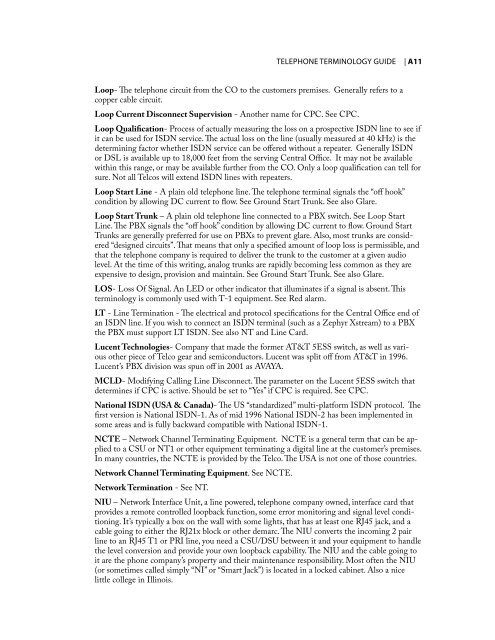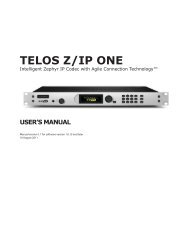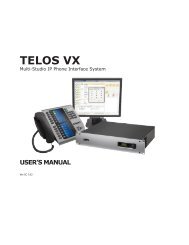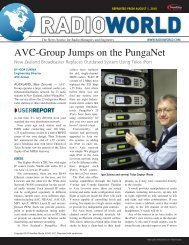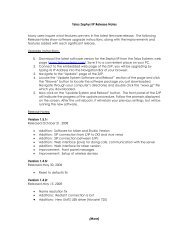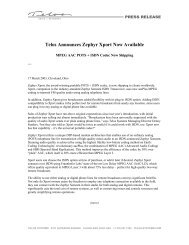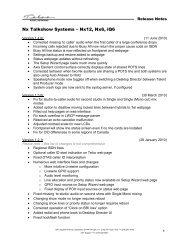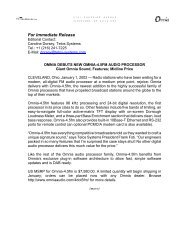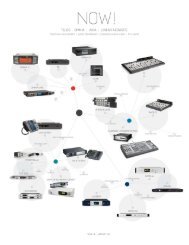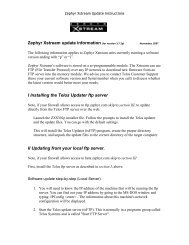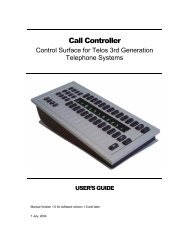Hx1-Hx2 Manual-1.4.1 - Telos
Hx1-Hx2 Manual-1.4.1 - Telos
Hx1-Hx2 Manual-1.4.1 - Telos
Create successful ePaper yourself
Turn your PDF publications into a flip-book with our unique Google optimized e-Paper software.
TelepHone TerMInoloGy GuIDe | A11<br />
Loop- The telephone circuit from the CO to the customers premises. Generally refers to a<br />
copper cable circuit.<br />
Loop Current Disconnect Supervision - Another name for CPC. See CPC.<br />
Loop Qualification- Process of actually measuring the loss on a prospective ISDN line to see if<br />
it can be used for ISDN service. The actual loss on the line (usually measured at 40 kHz) is the<br />
determining factor whether ISDN service can be offered without a repeater. Generally ISDN<br />
or DSL is available up to 18,000 feet from the serving Central Office. It may not be available<br />
within this range, or may be available further from the CO. Only a loop qualification can tell for<br />
sure. Not all Telcos will extend ISDN lines with repeaters.<br />
Loop Start Line - A plain old telephone line. The telephone terminal signals the “off hook”<br />
condition by allowing DC current to flow. See Ground Start Trunk. See also Glare.<br />
Loop Start Trunk – A plain old telephone line connected to a PBX switch. See Loop Start<br />
Line. The PBX signals the “off hook” condition by allowing DC current to flow. Ground Start<br />
Trunks are generally preferred for use on PBXs to prevent glare. Also, most trunks are considered<br />
“designed circuits”. That means that only a specified amount of loop loss is permissible, and<br />
that the telephone company is required to deliver the trunk to the customer at a given audio<br />
level. At the time of this writing, analog trunks are rapidly becoming less common as they are<br />
expensive to design, provision and maintain. See Ground Start Trunk. See also Glare.<br />
LOS- Loss Of Signal. An LED or other indicator that illuminates if a signal is absent. This<br />
terminology is commonly used with T-1 equipment. See Red alarm.<br />
LT - Line Termination - The electrical and protocol specifications for the Central Office end of<br />
an ISDN line. If you wish to connect an ISDN terminal (such as a Zephyr Xstream) to a PBX<br />
the PBX must support LT ISDN. See also NT and Line Card.<br />
Lucent Technologies- Company that made the former AT&T 5ESS switch, as well as various<br />
other piece of Telco gear and semiconductors. Lucent was split off from AT&T in 1996.<br />
Lucent’s PBX division was spun off in 2001 as AVAYA.<br />
MCLD- Modifying Calling Line Disconnect. The parameter on the Lucent 5ESS switch that<br />
determines if CPC is active. Should be set to “Yes” if CPC is required. See CPC.<br />
National ISDN (USA & Canada)- The US “standardized” multi-platform ISDN protocol. The<br />
first version is National ISDN-1. As of mid 1996 National ISDN-2 has been implemented in<br />
some areas and is fully backward compatible with National ISDN-1.<br />
NCTE – Network Channel Terminating Equipment. NCTE is a general term that can be applied<br />
to a CSU or NT1 or other equipment terminating a digital line at the customer’s premises.<br />
In many countries, the NCTE is provided by the Telco. The USA is not one of those countries.<br />
Network Channel Terminating Equipment. See NCTE.<br />
Network Termination - See NT.<br />
NIU – Network Interface Unit, a line powered, telephone company owned, interface card that<br />
provides a remote controlled loopback function, some error monitoring and signal level conditioning.<br />
It’s typically a box on the wall with some lights, that has at least one RJ45 jack, and a<br />
cable going to either the RJ21x block or other demarc. The NIU converts the incoming 2 pair<br />
line to an RJ45 T1 or PRI line, you need a CSU/DSU between it and your equipment to handle<br />
the level conversion and provide your own loopback capability. The NIU and the cable going to<br />
it are the phone company’s property and their maintenance responsibility. Most often the NIU<br />
(or sometimes called simply “NI” or “Smart Jack”) is located in a locked cabinet. Also a nice<br />
little college in Illinois.


